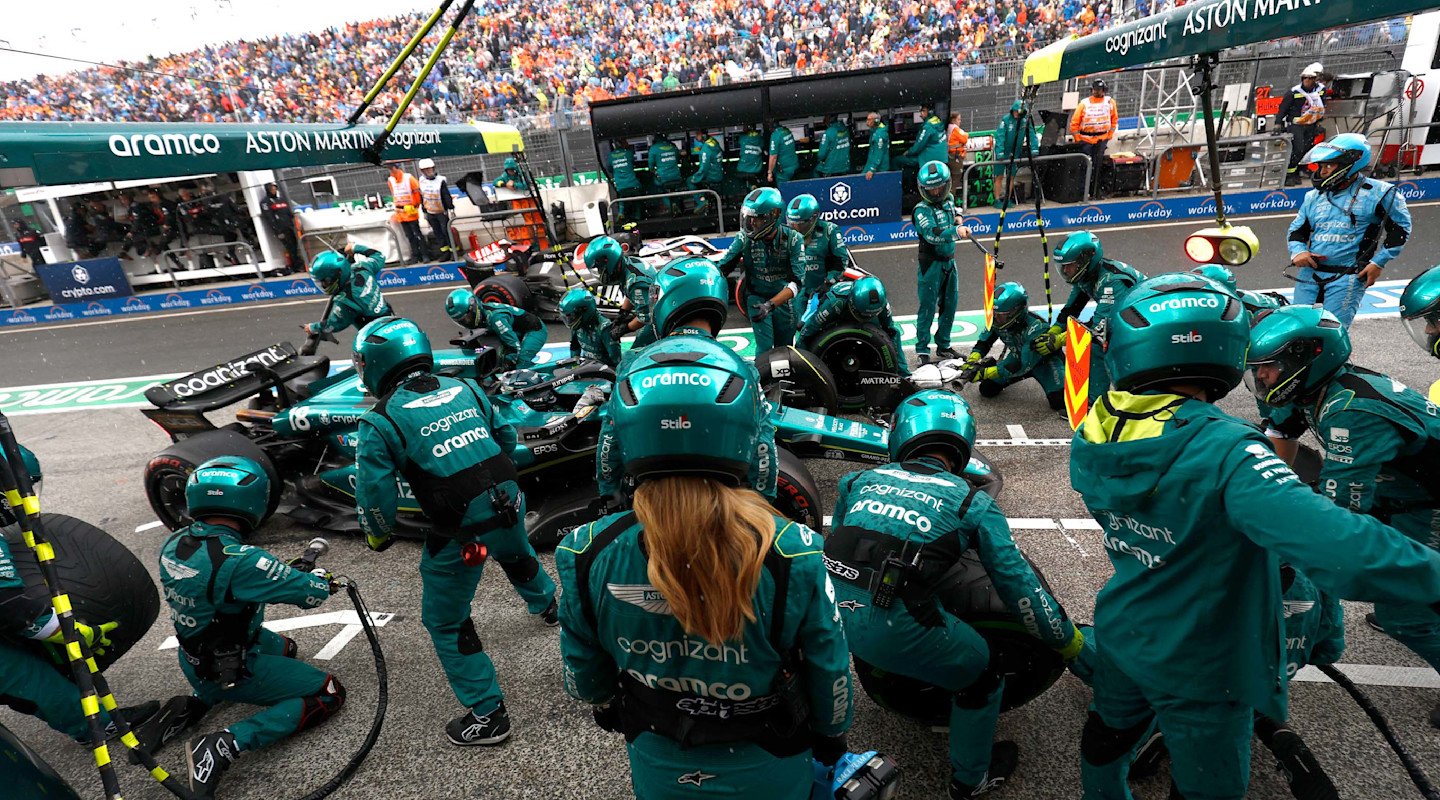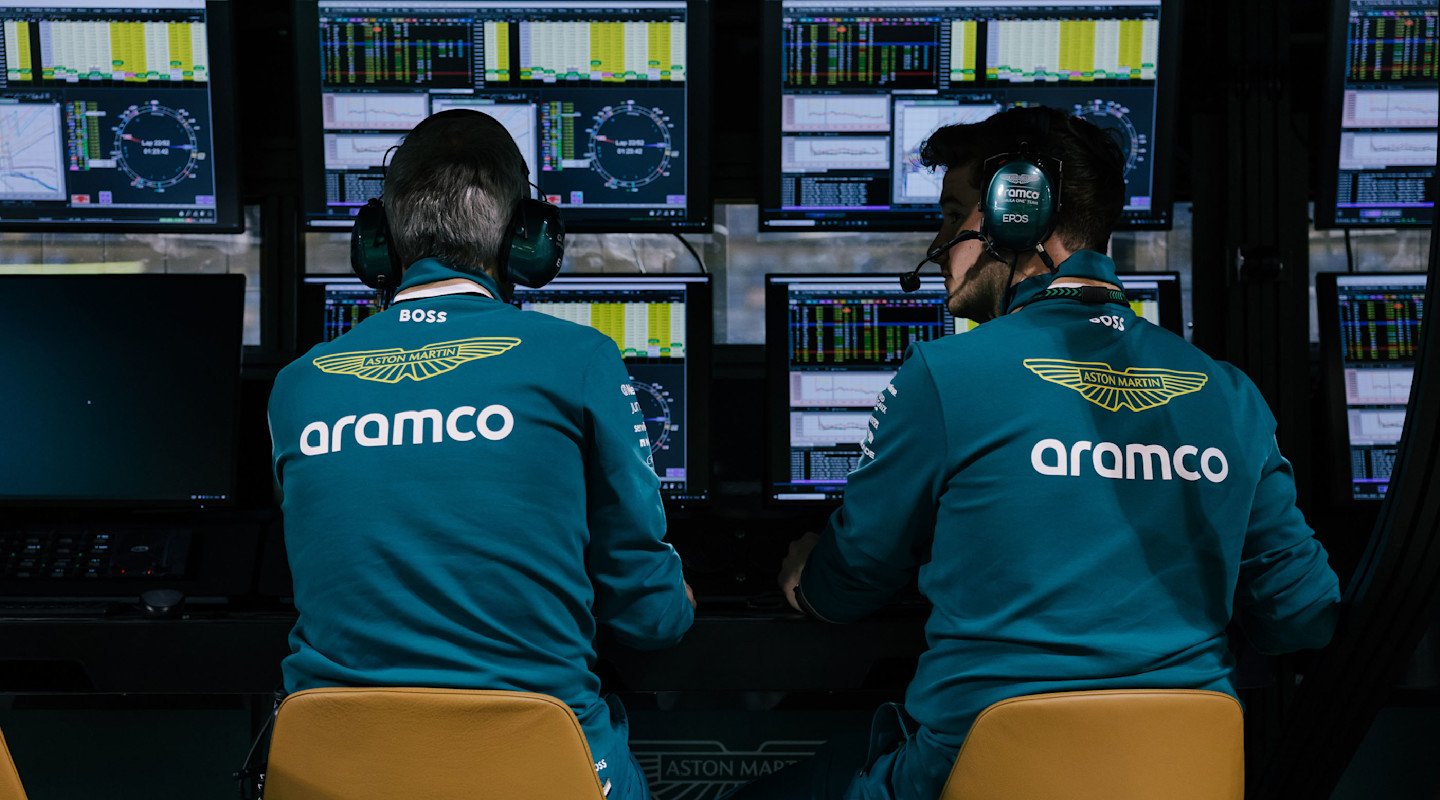
Illuminating, honest and definitive. Aston Martin Aramco Formula One Team Performance Director Tom McCullough reveals what race strategy is all about and what it takes to be an F1 strategist.
A simple case of getting from A to B; F1 strategy engineers must plot a path to the best possible finish in a Grand Prix, guiding driver and car from the start line to the chequered flag, some 305km later, in the shortest time. On the surface, it sounds like a straightforward task – in reality, it's anything but.
It requires a carefully devised plan of attack and an ability to adapt and react to an ever-changing scenario. It's easy to make the calls from the comfort of your armchair at home, usually with the benefit of hindsight, but in the heat of the moment on the pitwall – in the turbocharged pressure cooker that is F1 – it's an altogether very different proposition.
F1 strategy engineers are key players in the fastest game of chess on the planet, and Aston Martin Aramco Formula One Team Performance Director Tom McCullough reveals what it takes to be one and how you could find a career opportunity in this field.
What does an F1 strategy engineer actually do?
"Responsible for the preparation, implementation and analysis of race strategies, a strategy engineer works closely with tyre engineers, race engineers, drivers and anyone with input at a senior level, to play out as many scenarios as possible to devise the optimal plan for a race.
"Using AI and machine learning, they simulate thousands of scenarios and even update the simulations and strategy during the race based on real-time data from the track. It's a dynamic, fast-paced role with the power to shape the outcome of a Grand Prix."
What we're looking for
"Firstly, you need to have a passion for motorsport – take a keen interest in it and have an excellent knowledge of it. Those who are passionate about the sport and the role, will add value to the team and make a difference. They will help drive us forward on our journey.
"Strategy engineers typically come from a mathematical background and have a strong engineering degree. With excellent problem-solving skills and the ability to think logically under pressure, they must be able to comprehend and analyse significant amounts of data.
"For those interested in a career in this field, we're looking for people who understand the theoretical side, but also the practical side – because if you just do strategy by numbers, it will go wrong. A budding, young strategy engineer needs to build their situational awareness so they can take into consideration every aspect of an entire race weekend.
"For example, it's very easy to write a model of how tyres are expected to perform in the race after Free Practice One, but you have to consider that the conditions in that session may not be representative of those that the tyres will be subjected to in the race. The track may have evolved in terms of grip levels to be several seconds quicker, the temperature may be higher, the setup of the car may be different and, therefore, the tyres will perform differently."

The tools of the trade
"We create most of our simulation tools ourselves – and we're always looking at ways to enhance and refine them. Strategy engineers must continually develop the tools we use to enable consistently easier and better decision-making at every race weekend of the year.
"People who are adept at developing these simulation tools are hugely beneficial to the team. Being able to code and be comfortable with programming in languages such as Python, Java, MATLAB and C# will help you stand out from other applicants."
It's one of the toughest jobs on the grid
"In theory, strategy is very simple. It's easy to work out the fastest way from the start line to chequered flag when you know race duration, tyre life, tyre degradation, pace difference between tyre compounds and pit loss, but the challenge is being able to predict and react to what happens in reality.
"You're constantly reacting to live events and data. There are so many variables: field spread; actual tyre degradation; actual tyre performance; Safety Cars; pit windows; track positions; what your competitors are doing."

The hardest thing for strategy engineers to learn is…
"What to do when things don't go to plan – how to react and make the best decision. It's all about situational awareness and we do a lot of training on this – being able to take a step back and look at what's actually happening.
"You have to be agile; the best strategy teams are very agile. We'd all love to do the strategy after the race with the benefit of hindsight, but you can't do that. It's only live once. You have to decide in the moment. That's what makes this job so challenging."
Communication is key
"You need to ensure your drivers understand the strategy. Before a race we talk through the different plans with the drivers, so they know what plans A, B, C, and so on, are. Then, in the race, if the driver says, 'I'm really struggling with the tyres, I don't reckon we're going to do plan A, I think we should be looking at plan B,' that's really useful feedback and we can react based on that information.
"We might elect to switch to plan B, another plan or, for example, a tyre engineer might provide more insight at this point and add, 'The driver is saying this because the tyres are overheating, but if we wait until the tyres cool down, the grip level will improve, and we can stick to plan A.'
"Having that kind of dialogue between the relevant people in the team, the driver, those who understand the tyres, the strategy, and the setup, is key. These are the kind of discussions we're constantly having over the intercom channels during a session so if you're pursuing a career in this area you need to be a confident, effective and efficient communicator."

You can't always rely on the driver
"Although driver feedback is an incredibly useful tool to establish whether we're on or off plan, or even provide us with new information that we might want to adapt our plans to, it comes with the caveat that drivers don't have all the information. Blindly following every call and suggestion a driver makes is very risky.
"For example, in a wet-dry race, a driver might ask for a pitstop to change from wet to dry tyres, but they can't see the pitstop windows. It's up to us to give them the full picture, explaining that pitting would drop them into traffic behind drivers on Intermediate tyres and cost more time than staying out on the used wet tyres for a little longer and then pitting into clear air."
You will make the wrong call
"Despite all the talented and experienced people in the team, the reams of information at your disposal, the data, the technology and resources, you won't always make the right strategy call. One of the hardest things to understand is how the tyres are going to work in specific conditions and this will inevitably catch you out at some point.
"It's very easy to pick a conservative strategy. The more aggressive the strategy, the more you stand to gain – but there is an increased risk of it going wrong. You make these calls based on the information and models you have at the time – the knowledge you and the team have of how the car works with the tyres in certain conditions. However, you can't always know this for definite, they're only models, and that's why your projections won't always be right."
But when you make the right call…
"In those races where you've done a better job as a team, when everyone has come together – the strategy group, the tyre group, the race engineers, everyone at the track and back at base – and you've made decisions different to your competitors and those decisions proved to be the right ones, that's what gives you a real buzz. Being a strategy engineer is incredibly tough, but it's equally rewarding when you get it right."
Bring your energy and be part of the journey. With a rich heritage and a fresh perspective, we’re shaking up the order and determined to compete at the sharp end.
Talented. Passionate. Driven. Our people are what set us apart and, together, we’re changing the game on and off the track.
Discover the roles we’re recruiting for at Aston Martin Aramco Formula One Team and make your next career move.

Amplify your fan experience
From exclusive collabs to once-in-a-lifetime prizes, I / AM DROPS is a new series of unique and ultra-limited moments and fan experiences.
The first DROP? A partnership The Rolling Stones. Sign up for I / AM or sign in to unlock the DROP.









































